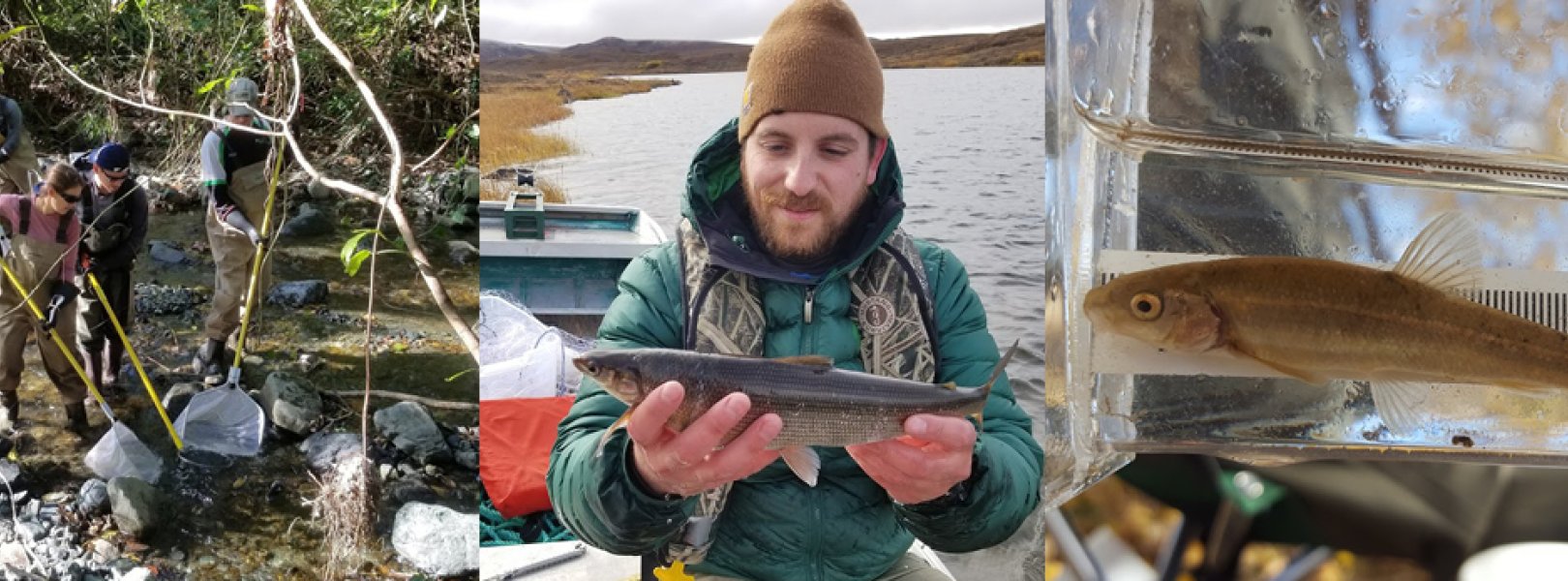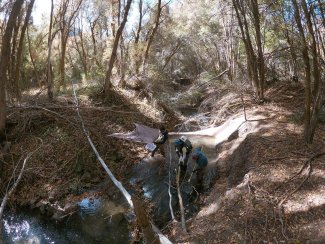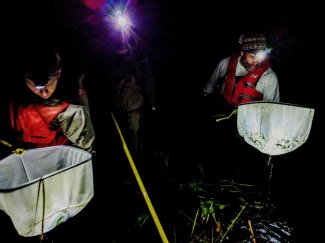Fish

Fish are an essential part of freshwater aquatic ecosystems. As a keystone predator, fish have an exceptionally large impact on their environment relative to other species. They transfer energy and nutrients throughout the food chain by eating other fish and macroinvertebrates and in turn being eaten by other predators. Studying these interactions is critical to understanding the impacts of pollutants on ecosystem food webs. The knowledge of how species are connected is also vital for understanding how natural and man-made environmental pressures affect ecosystems.
In addition to their ability to alter aquatic ecosystems as top consumers, fish are also particularly useful indicators of ecological integrity because they are influenced by a variety of processes and regimes (i.e., resource availability, anthropogenic physiochemical disturbances), and are relatively long-lived species. By understanding the composition of the fish community, researchers can quantify community structure and calculate metrics of ecosystem health. By collecting data related to fish diversity and populations, NEON aims to give researchers the tools they need to gain a complete picture of the food chain in aquatic ecosystems across the United States.

Fish sampling at the REDB field site
Field scientists for the NEON program conduct fish sampling at five lakes and 23 wadeable stream sites across the United States to quantify interannual variation in the abundance, health, diversity, and distribution of fish populations. Collecting fish community data can provide early indicator information on the changing health of an aquatic ecosystem. Sampled fish are identified, photographed, measured, weighed, and then released. Some fish tissues are collected, and DNA sequenced for additional taxonomic information.
Sampling Design
Temporal and Spatial Sampling Design
Data are collected in the spring (beginning of the growing season) and fall (end of the growing season) at all NEON wadeable stream sites except for Como Creek (COMO) and Martha Creek (sampled fall only), and all lake sites except for Suggs Lake (SUGG) and Barco Lake (BARC). Fish data collected at the beginning and end of the growing season can provide researchers with a picture of within-season fish development (growth) and how different species use the stream or lake habitats throughout the biologically active period. Although the timing may vary from site to site due to seasonal or logistical constraints (e.g., restrictions during fish spawning seasons), protocols have been developed to ensure those data will be comparable between sites and over time.
At wadeable streams, NEON’s one km aquatic site is divided into ten 80-120 m fish sampling reaches. The reaches are laid out using habitat features (i.e., natural breaks such as pools or rapids) and are actively sampled using a backpack electrofisher. Each year six of the ten reaches are sampled, once in the spring and once in the fall. Of these six, the same three are considered fixed and sampled every year for the life of the program. The remaining three reaches are "random". Random reaches are rotated each year, so that all reaches are fished over the course of the study.
Lake sites are divided up into pie-shaped segments with each “piece” containing a portion of the shoreline as well as sections of the lake. Each year six of these stations are sampled for fish using electrofishing, fyke, and gill net sets. Three segments are established as "fixed" sampling stations, and these same three stations are sampled every year for the life of the program. The remaining sections are considered "random" sampling stations and three of these are sampled every year. Random sampling stations rotate yearly so that all habitat types within the lake are fished over the course of the program.
Fish Sampling

Fish sampling in the Blue River (BLUE) field site. Photo credit Gary Henson.
The NEON program does active sampling (using mobile sampling gear) in wadeable streams and lakes, and passive sampling (using fixed sampling gear) at lake sites. NEON fish sampling protocols follow the guidelines recommended by the American Fisheries Society (AFS; Bonar et al. 2009) and have been chosen to align with those of USGS National Water-Quality Assessment (NAWQA; Meador et al. 1993) and USEPA National Aquatic Resources Survey (NARS; Peck et al. 2006, USEPA 2013).
- Fish are sampled two times per year, once in the spring and again in fall
- Collected fish are identified to the lowest practical taxonomic level
- A subset of captured individuals is weighed and measured
- Fin clips are collected from 5-10 individuals of a target species
- Fish are anesthetized prior to handling and then released once the data have been collected
Field ecologists for the NEON program conduct fish sampling at 28 lake and wadeable stream sites across the United States to quantify interannual variation in the abundance, health, diversity, and distribution of fish populations. Collecting fish community data can provide early indicator information on the changing health of an aquatic ecosystem. Sampled fish are identified, photographed, measured, weighed and then released. Some fish tissues are collected and DNA sequenced for additional taxonomic information. A subset of these tissues are also archived into the NEON Biorepository.
Active Sampling
Active sampling involves NEON field scientists moving through a sampling reach and using just enough electrofishing to immobilize fish so that they can be captured, identified, weighed, and measured. The process requires up to four scientists: one armed with a backpack electrofisher to immobilize fish, two with dip-nets to collect the fish, and one with a bucket to provide a holding reservoir for fish to recover.

Night lake electrofishing at the CRAM field site (Photo by: Brandon Jensen).
Passive Sampling
Active sampling at lakes occurs in nearshore habitats, but lake species can and will use all the habitats provided by a lake. Backpack electrofishing does not allow NEON to accurately assess fish that exclusively use deepwater habitats (pelagic) or fish that utilize both pelagic and nearshore habitats. To ensure that NEON captures the full extent of fish habitats at lakes, NEON uses two different passive sampling methods, one for sampling fish in shallow nearshore habitats and the other for sampling fish at deeper depths. In nearshore habitats, mini fyke nets are deployed for eight to 12 hours. Fyke nets are long stationary nets that entrap fish that swim into them. In deeper areas, experimental gill nets are used. These nets have several panels of various mesh sizes to collect both small and large fish and thus get a representative sample of the fish community. Because gill nets capture fish by entanglement and can cause damage to individuals, these nets are only deployed for 1-2 hours to reduce fish injuries.

Fish sampling at GUIL
Fin Clips for DNA Analysis
Fish sampling includes the collection of fin clips for DNA Analysis from a subset of fish at each site. To learn more about NEON DNA Sequences please visit the NEON DNA Sequences page.
Data Products
Counts of fish species and DNA sequence samples are collected concurrently. All data are open access and downloadable from the NEON Data Portal. Fish data include:
- Fish electrofishing, gill netting, and fyke netting counts (DP1.20107.001)
- Fish sequences DNA barcode (DP1.20105.001)
Archival Samples
Archival samples of whole fish and DNA extracts from fin clips, as well as vertebrate bycatch, are available from the NEON Biorepository.
| Types of Samples | Storage Condition | Storage Container | Quantity Archived (Annually) † | Link to the Collection |
|---|---|---|---|---|
| Fish, whole vouchers | 70% ethanol | individuals or lots | 450 to 700 samples | Fish Collection (Vouchers) (NEON-FISC-V) |
| DNA extracts from fish fin clips | -80°C | 96-well plates‡ | 475 to 570 extracts | Fish Collection (DNA Extracts) (NEON-FISC-DNA) |
| Vertebrate bycatch from fish sampling | 70% ethanol | individuals or lots | 0 to 20 samples |
† Quantities represented in this table are annual quantities expected from sampling conducted throughout the observatory during full Operations. Actual quantities may differ from these projections
‡ Quantities are number of samples (not number of well plates); up to 96 samples are contained on the same well plate